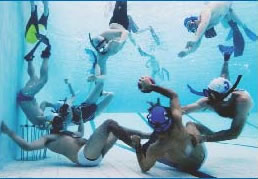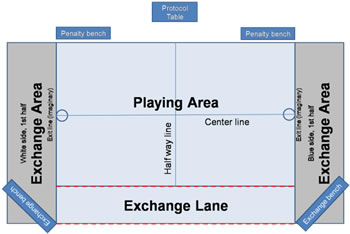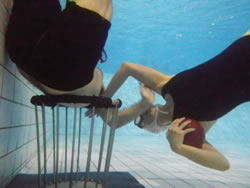International Tournament For Putney Based GB Team
Putney's underwater rugby team takes first overseas tour
In October last year
the first British Underwater Rugby team made it's home in Putney Leisure Centre and now less than six months on the team is taking their first overseas tour!

It sounds bizarre but the 10-strong British Sub-Aqua Club (BSAC) team will travel to Florence for an international underwater rugby tournament, the first time a team from the UK has taken part in a sport which is played in many parts of the world.
The game has little in common with rugby and is played in a pool by two teams of six wearing snorkels and masks. The aim is to get the round ball - filled with sea water so it doesn't bob to the surface - into the opposition's basket.
The driving force behind this little known sport in the UK is Slovakian Oliver Kraus.
He wanted to carry on playing his favourite game when he arrived in London 10 years ago but failed to find a club after months of searching.
Now he has formed the capital city's first underwater rugby club thanks to the support of BSAC, the governing body for sport diving in the UK.
Oli, 33, who studied at the University of Essex before becoming a database manager, launched PURE Underwater Rugby Club in June last year along with Robert Bonnar, Gemma Witts and Roy Sherwin of the Teddington branch of BSAC and is based at Putney Leisure Centre.
Oli said: "Underwater rugby is a brilliant game and I used to play at home in Bratislava, but when I arrived in the UK and looked for a club I simply couldn't find one. It's a physical game and you need to be fit. Players have to hold their breath for long periods and we get through a lot of cardio work."
"I was really surprised there were no clubs in the UK, at least not around London. Wherever I have gone, such as Munich, Moscow and even Boston in the US I have managed to find a club and have a game."
Setting up the club was not easy because the UK is not part of the World Confederation of Underwater Activities which governs sports like underwater rugby.
But a lifeline came from BSAC which allowed the club to operate under its umbrella.
BSAC is made up of 120 dive centres and 1,000 plus family friendly and sociable clubs, run by volunteers, up and down the country and abroad.
It represents around 30,000 snorkellers and scuba divers and provides extensive and safe diver training from beginner to expert. It welcomes membership of divers trained by all other agencies.
Oli commented that: "Without the help of BSAC we wouldn't have been able to rent a pool, and insurance costs would have been prohibitive. I am so grateful for all their help and support."
Fellow founder member Roy Sherwin, a diving and snorkelling instructor and a member of Teddington branch of BSAC, said: "It's a wonderful fast-moving game and a fabulous way to stay fit. I'm sure the club will go from strength to strength and we will see more people trying the sport. We are lucky that Oli has officially introduced this sport to the UK and that he has done so through BSAC. We should all be very proud of him!”
As a member of the BSAC London regional coaching team, Roy has assisted with technical matters regarding safety issues and provided snorkel training.
He is keen to encourage more teams to get started and added:
“As soon as that starts happening we can have inter-branch competitions and this would be good fun for all of us.”
 All 14 members are now BSAC members and the club would welcome anyone who wants to give the sport a try.
All 14 members are now BSAC members and the club would welcome anyone who wants to give the sport a try.
Oli said: "We have a good mix of male and female players including a Finnish girl, who has joined after initially learning to play underwater hockey."
The club meets every Thursday at 9pm at Putney Leisure Centre.
*For more information about BSAC visit www.bsac.com and for more information about PURE Underwater Rugby visit the club website at www.underwater-rugby.webs.com
*To watch a PURE Underwater training video visit # www.youtube.com/watch?v=7c-fqXGpVfo
Underwater Rugby — The Game
Underwater rugby contests match two teams of twelve players. A team may have a maximum of 6 players in the water. The reserve players may dive in when the player they replace is fully out of the pool. The action is intense. A player usually lasts for three or four dives and then exits the pool to recover.
The teams are distinguished by suit color, either blue or white. Apart from swim suits and caps (the same kind as found in water polo), the kit includes mask, snorkel and fins. Points are scored whenever a team puts a ball in the goal, of which there are two on opposite sides of the pool in the deep end. The depth of a pool must be between 3.5 meters, the shallowest allowed by the World Underwater Federation (CMAS) rules, and 5 meters, the deepest.
Much of the action takes place entirely beneath the surface. In fact, it is against the rules for the ball to leave the water completely; it may break the surface but may not be lifted out of the water. Passing is allowed in all directions. The ball, which sinks, can only be thrust a short distances because of water resistance. Underwater rugby shares many of the same characteristics as many team ball sports on land. As in hockey, basketball or football, underwater rugby players are divided by position.
The typical modern scheme has two goalies, two forwards and two defensive backs. Generally players sharing a position take turns diving. While on defense, for example, one goalie guards the basket while the other breathes at the surface before descending to takeover goal keeping. To avoid anaerobic exertion as much as possible good team players establish a rhythm that allows them to avoid both coming up the same time for air, a lapse which often creates a dangerous goal scoring opportunity.
Each player brings his own individual package of strengths. Power, speed and agility are important. Decisiveness, will power and lung capacity set some players apart. The ability to read play requires experience. Some players excel in their ability to foresee and counteract threats. Teamwork is essential to success on both ends of the pool. This interplay of factors is one reason that men and women routinely train and even compete together.
Playing Area
There are no pools specifically designed for underwater rugby. The playing area is 12 to 18 meters long and between 8 and 12 meters wide. To delineate the playing area a line with floats is strung across the pool. Parallel to that line is another that creates the three-meter wide exchange lane, giving the substitutes a place to dive in.

Goals

The goals consist of two rigid baskets, each of which is located in the middle of its respective end of the playing area on the bottom of the pool as close to the wall as possible. The top of the basket, which is usually made of steel tubing on top of a metal base, is padded. The goals should not shift during play but sometimes do because they are not fixed to the pool bottom.
April 25, 2014